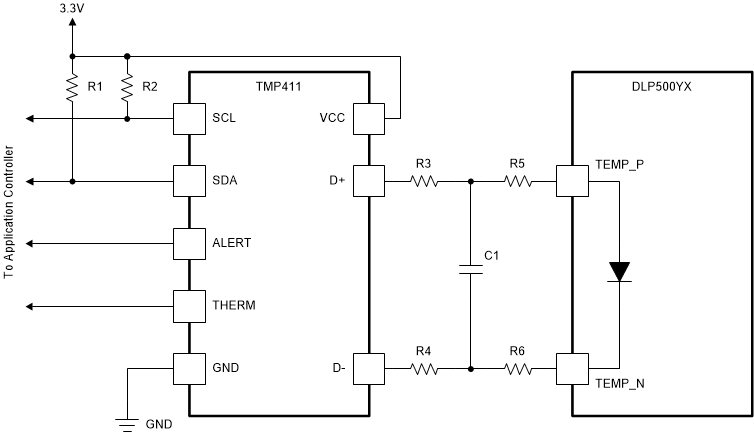ZHCSKV7A November 2020 – July 2022 DLP500YX
PRODUCTION DATA
- 1 特性
- 2 应用
- 3 说明
- 4 Revision History
- 5 Pin Configuration and Functions
-
6 Specifications
- 6.1 Absolute Maximum Ratings
- 6.2 Storage Conditions
- 6.3 ESD Ratings
- 6.4 Recommended Operating Conditions
- 6.5 Thermal Information
- 6.6 Electrical Characteristics
- 6.7 Capacitance at Recommended Operating Conditions
- 6.8 Timing Requirements
- 6.9 Typical Characteristics
- 6.10 System Mounting Interface Loads
- 6.11 Micromirror Array Physical Characteristics
- 6.12 Micromirror Array Optical Characteristics
- 6.13 Window Characteristics
- 6.14 Chipset Component Usage Specification
- 7 Detailed Description
- 8 Application and Implementation
- 9 Power Supply Recommendations
- 10Layout
- 11Device and Documentation Support
- 12Mechanical, Packaging, and Orderable Information
8.3 DMD Die Temperature Sensing
The DMD features a built-in thermal diode that measures the temperature at one corner of the die outside the micromirror array. The DMD thermal diode pins B17 and B18 can be connected to the TMP411 temperature sensor as shown in Figure 8-2, and an external processor can interface with the TMP411 temperature sensor over I2C bus to allow monitoring of the DMD temperature. This temperature data can be leveraged to incorporate additional functionality in the overall system design such as adjusting illumination, fan speeds, and so forth, all with the idea of maintaining appropriate temperature control of the DMD.
